|
|
Post by sheshki on Feb 2, 2011 15:40:55 GMT -5
On the picture of the stele of Naram-Sin Enkur posted are shown two standards. They have probably a moon or a winged figure mounted. 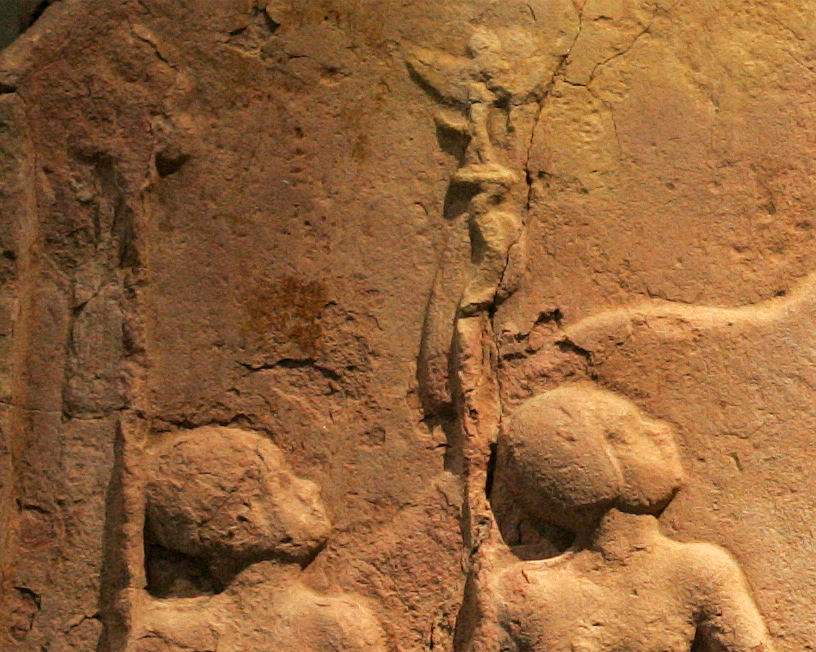 |
|
|
|
Post by sheshki on Apr 23, 2011 18:06:04 GMT -5
mu szu-nir mah ku 3-sig 17 husz-a igi-du {gisz}giszimmar eren 2-na-ke 4 dingir gal-gal-e-ne-sze 3 a 2-dah-a-ni-sze 3 mu-un-ne-dim 2-ma Year in which (Hammurabi) made for the great gods his helpers a magnificent emblem of redish gold, a palm-tree which goes in front of the armyPost number 500. Invisible drinks for everyone  |
|
|
|
Post by sheshki on Sept 27, 2011 12:43:11 GMT -5
I hope that the web page is fixed up some time this year. It took only a year and a day to fix it... |
|
|
|
Post by madness on Mar 27, 2012 5:40:06 GMT -5
hmm you still have a bizarre (and wrong) image for Der.
"the snake" is Der
and "the spread eagle" (bird) is possibly Shuruppak
|
|
|
|
Post by sheshki on Dec 8, 2012 8:42:00 GMT -5
|
|
|
|
Post by sheshki on Dec 8, 2012 12:48:16 GMT -5
|
|
|
|
Post by sheshki on Aug 7, 2013 5:56:01 GMT -5
From Rituals of War by Zainab Bahrani, Chapter 7 Omens of Terror:
Similar values seem to have been ascribed to military equipment and battle standards.
Such standards often appear in the sculpted Neo-Assyrian battle reliefs,
as well as in much earlier images of battle. The Victory Stele of Naramsin shows
Akkadian troops carrying tall standards with heraldic and divine emblems, and similar standards
appear in reliefs from the third dynasty of Ur. In the first millennium BC, different divisions
of Assyrian troops, each with its own patron deity and designated standard marched into battle.
For example, a text mentions Nergal/Erra on the right and Adad on the left, and the chariots
of Nergal and Adad. Texts describe the gods´chariots as accompanying the king into battle
and images of deity emblems are represented in the Neo-Assyrian reliefs of war hovering over
the chariot of the king as warrior.
The chariots themselves had attached deity-emblem protomes, which were at once heraldic
and atropaic. The lion protomes of Nergal, the bull-headed attachments of Adad,
the emblem of the archer god Ninurta, a winged disc bearing the god Assur,
and Ishtar in a medallion in form of a star-nimbus all appear on Assyrian war equipment.
The yoke poles of the chariots to which the harness was attached are depicted with rosette
and star-nimbus of Ishtar, the crescent moon of the moon god, Sin, and the Sebitti,
the seven Warriors, as well as dragon-headed and bird-headed protomes.
These types of emblems appear not only on chariots but also on the standards that
are represented in battle reliefs. The gods travelled in chariots.
When the cult statues were transported by land, it was in special vehicles,
and some references to the gods´ accompanying the troops at war may mean that
the cult statue was taken into battle. The chariots of the gods were part of a
military display that made a spectacle of power, which was integral to the tactics of war.
The gods mediated the decisions of war by means of omens, and they provide the vehicles and
the weapons, which had to be purified (elêlu) before and after battle.
|
|
|
|
Post by us4-he2-gal2 on Aug 8, 2013 8:41:25 GMT -5
Nice!  Bahrani's comment on standards is excellent here, very vivid, you get a sense of the battle and the mindset of those engaging in battle. Whenever I mention standards around Frayne he often says something like "they took them in to battle to.." always reminds me of that. But this is the most I've heard said about it. I suppose the psychological factor of having the manifestation of a god threatening you from among the closing ranks of enemy troops would be quite effective in itself. |
|
|
|
Post by sheshki on Jan 12, 2014 14:00:23 GMT -5
from: Why Cylinder Seals? Engraved Cylindrical Seal Stones of the Ancient Near East, Fourth to First Millennium B.C.
Author: Edith Porada
Of interest here is this post left and right of the temple:  A second Uruk period cylinder (Fig. 9) has in its center a temple toward which three men walk from the right, while from the left a man approaches in ritual nudity, in a boat that has at its bow and stern two plant designs that may form the sign for en.  Cylinder seal, a temple approached by worshippers, from Tell Billa, ca. 3200 B.C. (after Strommenger, pl. 17, 2nd row) \/\/\/\/\/\/\/\/\/\/\/\/\/\/\/\/\/\/\/\/\/\/\/\/\/\/\/\/\/\/\/\/\/
/\/\/\/\/\/\/\/\/\/\/\/\/\/\/\/\/\/\/\/\/\/\/\/\/\/\/\/\/\/\/\/\/\/In the cylinder the figure kneeling on one knee holds a gatepost  of the abode of Ea,the god of water, wisdom, and magic. 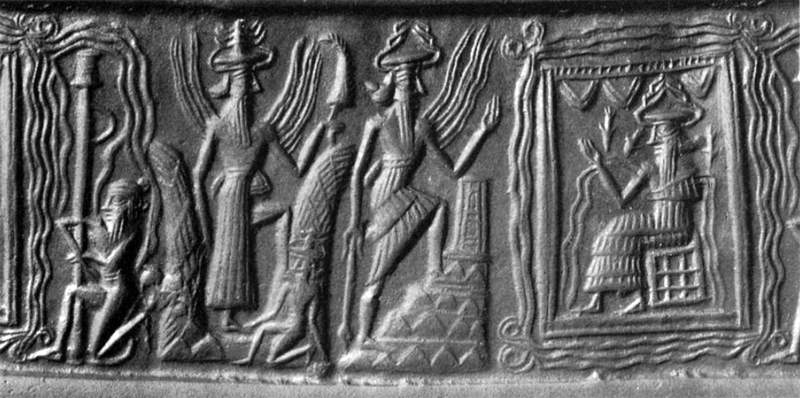 Cylinder seal from Ur, Akkade period style, mythological scene, ca. 2250 B.C. (after C. L. Wolley, Ur Excavations II: The Royal CemeteryL, ondon-Philadelphia, 1934, pl. 215, No. 364, U.9750) \/\/\/\/\/\/\/\/\/\/\/\/\/\/\/\/\/\/\/\/\/\/\/\/\/\/\/\/\/\/\/\/\/
/\/\/\/\/\/\/\/\/\/\/\/\/\/\/\/\/\/\/\/\/\/\/\/\/\/\/\/\/\/\/\/\/\/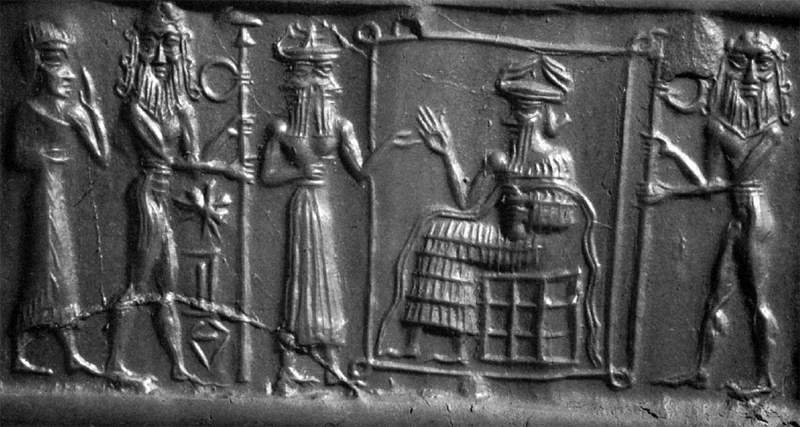 Cylinder seal, water god with adjuncts, Akkade period style, ca. 2250 B.C., Morgan 202 |
|
|
|
Post by sheshki on Jan 13, 2014 3:48:00 GMT -5
from Iranica OnlineAn important seal impression of the period [Middle Elamite] is the remarkable design of the judge Ishme-karab-ilu (Plate XLIV/2; Amiet, 1973b, pl. IX/48), which suggests the existence of a divine image on an elaborate metal structure. The stand is formed by two entwined serpents, which emerge from a mountain and are supported by two kneeling nude, bearded heroes (called lahmu by Wiggermann). Amiet notes that the minor deity standing in worship before the god on the structure wears a miter corresponding to that of a human- headed bull on a cylinder (Amiet 1972, no. 1909) that he considers contemporary but that seems somewhat earlier to this writer. 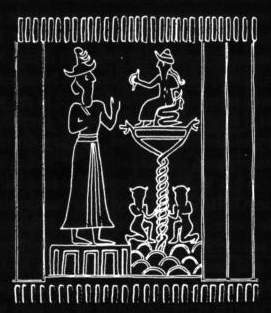 |
|
|
|
Post by sheshki on Jan 13, 2014 13:36:34 GMT -5
from Iranica Online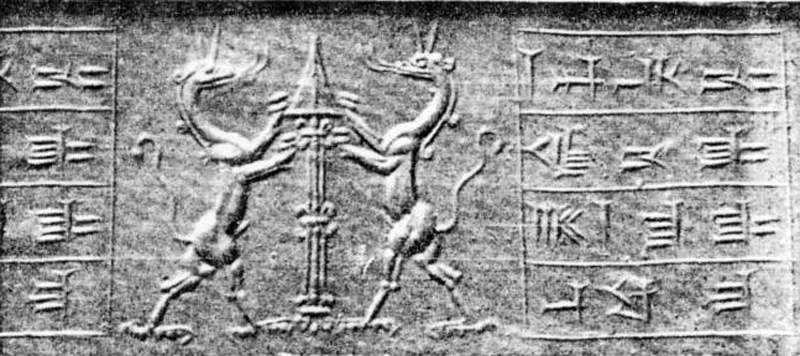 Impression of the cylinder seal of Hupan-kitin, son of king Shutruk-Nahhunte II. Neo-Elamite period. |
|
|
|
Post by sheshki on Jan 13, 2014 14:04:13 GMT -5
|
|
|
|
Post by sheshki on Jan 13, 2014 15:07:36 GMT -5
Discovered some more information about seal 49 from the previous post in: Ancient Art in Miniature: Ancient Near Eastern Seals from the Collection of Martin and Sarah Cherkasky by Holly Pittman (1987)
--->Link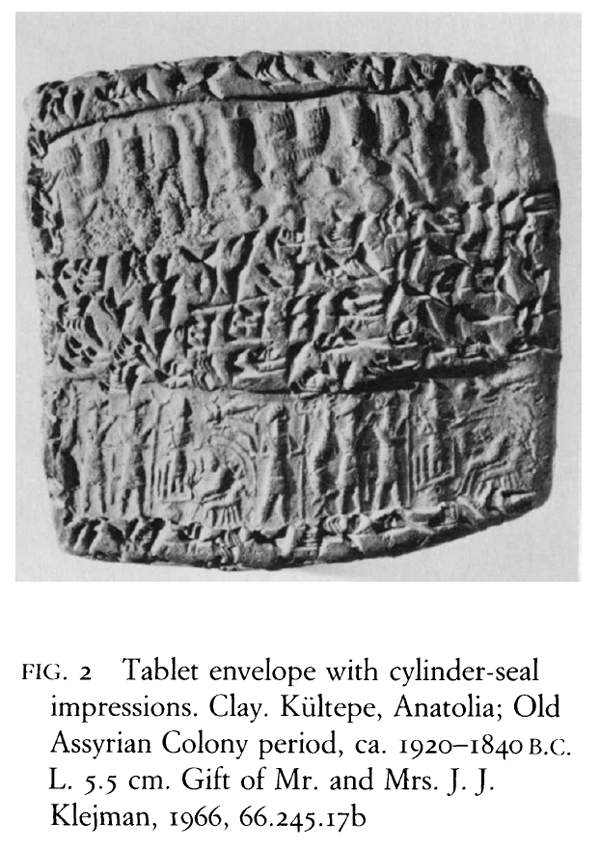 |
|
|
|
Post by sheshki on Jan 13, 2014 15:47:23 GMT -5
|
|
|
|
Post by sheshki on Jan 13, 2014 16:14:38 GMT -5
from: Beyond Babylon: Art, Trade, and Diplomacy in the Second Millennium B.C. --->Link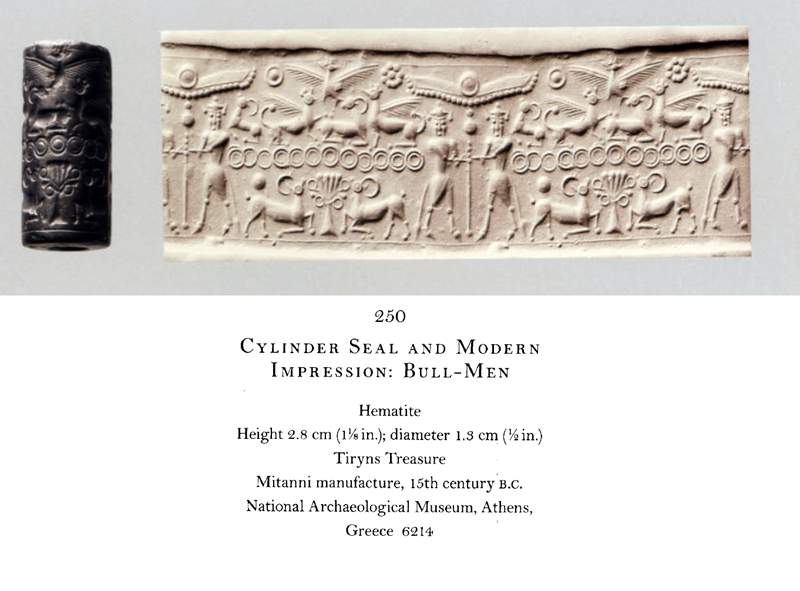 |
|
|
|
Post by sheshki on Jan 19, 2014 10:20:35 GMT -5
from the article Rivers in Anatolian Art? by Machteld J. Mellink published in Natural Phenomena, Their Meaning, Depiction and Description
in the Ancient Near East--->link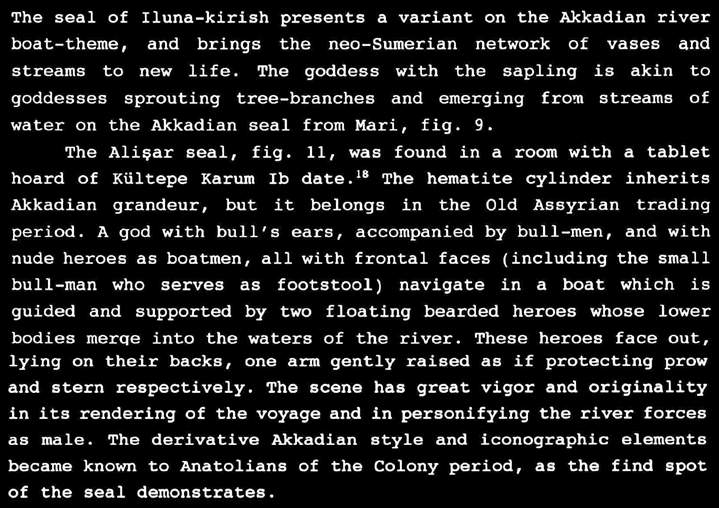 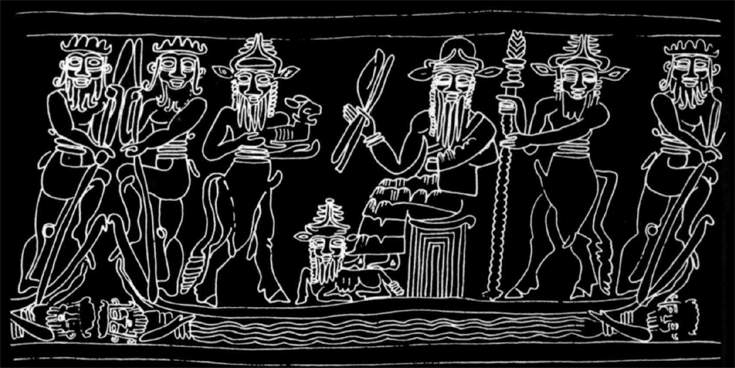 |
|
|
|
Post by sheshki on Jan 19, 2014 10:33:00 GMT -5
from the article A Cylinder with a Storm God and Problems by E. Porada published in Natural Phenomena, Their Meaning, Depiction and Description
in the Ancient Near East--->link 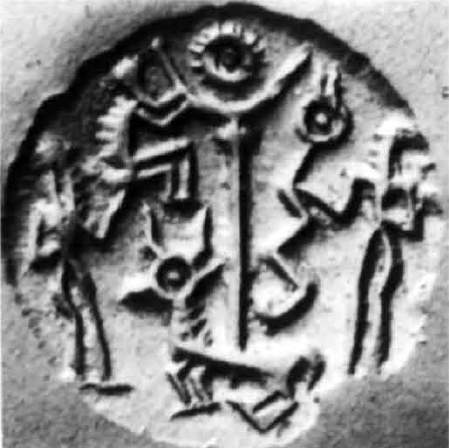 |
|
|
|
Post by sheshki on Jan 22, 2014 15:00:27 GMT -5
from: Rollsiegel aus einer hessischen Privatsammlungby Ellen Rehm---> Link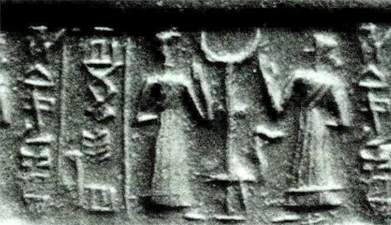 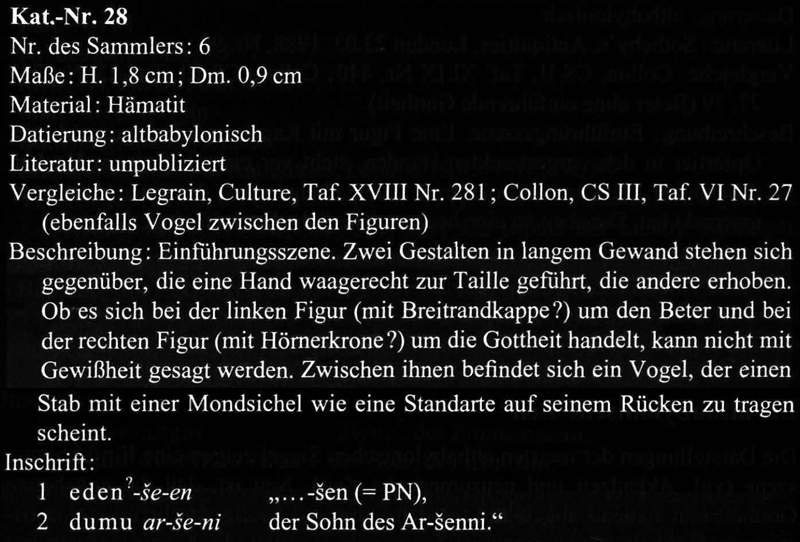  interesting here is the figure of the naked goddess on a platform, which was possibly a cultic statue. interesting here is the figure of the naked goddess on a platform, which was possibly a cultic statue. |
|
|
|
Post by sheshki on Jan 23, 2014 8:17:56 GMT -5
The mark of ancient man : ancient Near Eastern stamp seals
and cylinder seals : the Gorelick Collection / by Madeline Noveck. --->Link 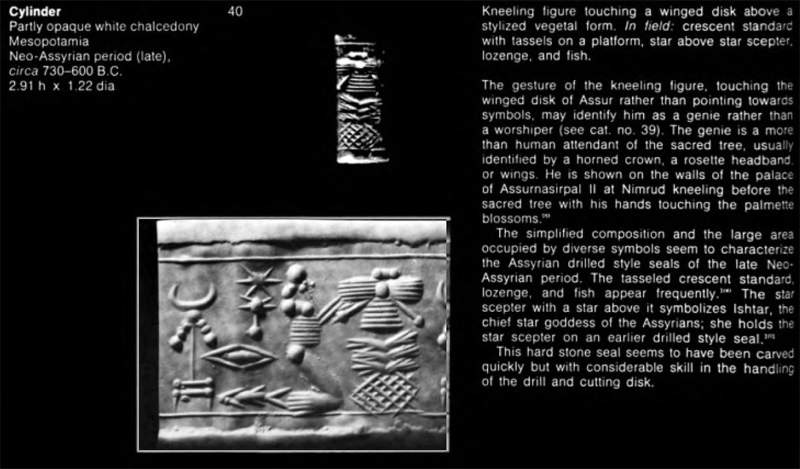
|
|
|
|
Post by sheshki on Jan 23, 2014 9:08:38 GMT -5
from: On Art in the Ancient Near East Volume I
Of the First Millennium B.C.E.by Irene J. Winter--->Link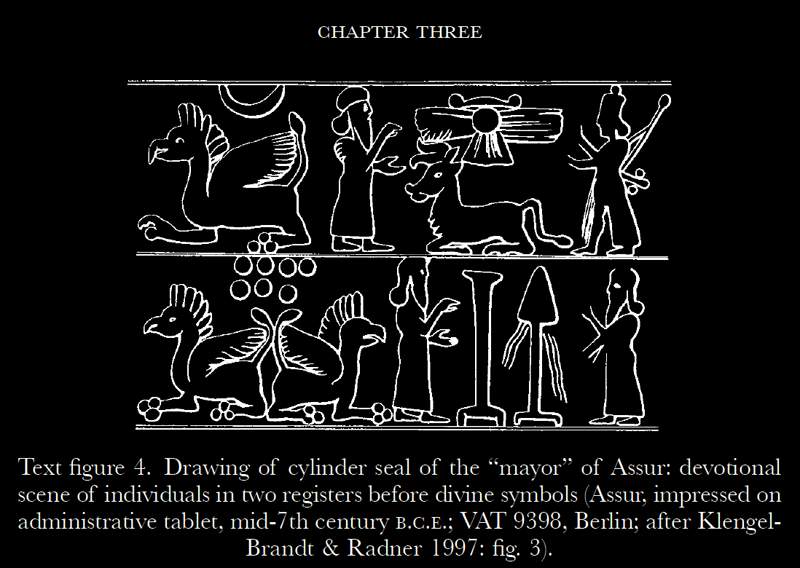  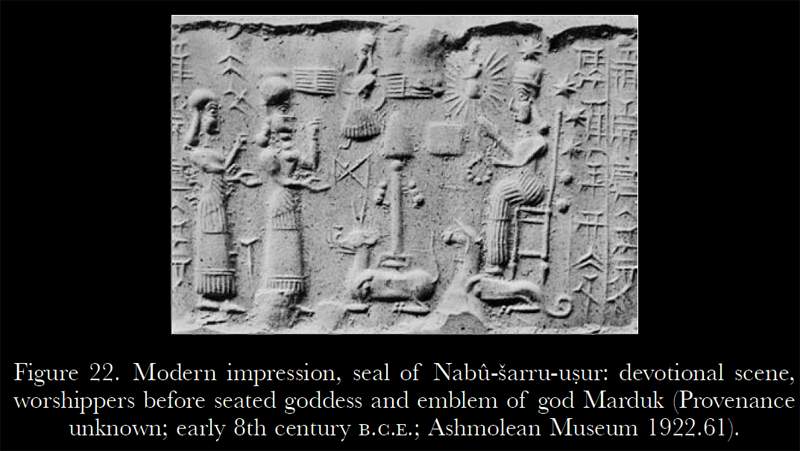 |
|
|
|
Post by sheshki on Jan 24, 2014 14:08:42 GMT -5
from: The Sumerian goddess Inanna (3400.2200 BC) by Paul Collins--->LinkThe Inanna sign also appears on sculptures, reliefs and cylinder seals contemporary with the Archaic IV/III tablets. A variety of scenes are depicted in association with the sign, but there are common motifs; for example, a bearded man wearing a net-cloak and Pathan-style hat is often depicted feeding stylised flowers to flocks of sheep and goats. Found in association with this scene are vases between two Inanna symbols. It has been suggested by Brandes (1 Cfl9) that the seals and sealings with similar designs represent the authority of the central temple and the man portrayed is the 'priest-king' of Uruk identified in texts as the en (Fig. 2). 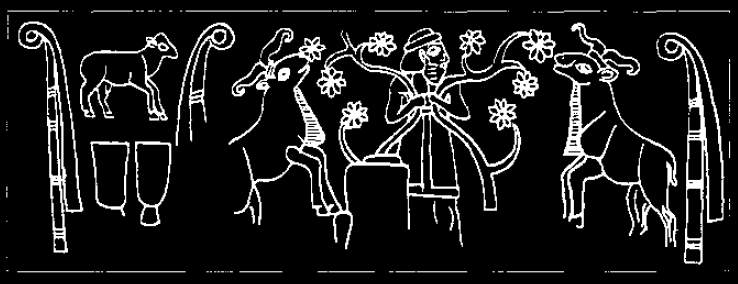 Fig. 2 Asher-Greve (1985) has convincingly argued that there are no representations of deities dating to the fourth millennium. Although no depictions of the goddess exist, the most important document for defining the role and functions of Inanna at this time is the Warka vase (Fig. 3). As suggested earlier, the relief on the vase depicts a double shrine of Inanna at Uruk. Furthennore, the objects within the sanctuary may relate to either of the two figures, perhaps cultic statues, standing on the back of bulls. I suggest that the vase in the form of a ram should be associated with the figure holding a 'stack of vessels', while the lioness vase (behind the ram) relates to the figure with an Inanna symbol (behind the figure with 'bowls'). The lioness and ram may represent two aspects of the goddess (perhaps the male and female principle), signified by the double Inanna symbols at the entrance to the temple. InannaJIshtar was often associated with a lion on cylinder seals and reliefs following the Akkad Dynasty, but an early connection between the two is found on a chlorite bowl discovered in the Inanna temple at Nippur, level VIII (EO Ill). The vessel depicts a snake in combat with a large cat, and is labelled in cuneiform 'Inanna and the serpent'. Inanna, conceived as a lioness, may represent the aggressive aspect of nature. The role of the ram found on the Warkavase, and depicted on contemporary cylinder seals and reliefs in association with the Inanna symbol, is less easy to define. It is not found associated with a deity in later periods but I suggest it may represent Inanna's role as goddess of fertility, an important aspect of Inanna according to later hymns and prayers. Inanna was thus easily equated with the Semitic goddess Ishtar who probably possessed similar attributes: as the 'skirmisher' Ishtar was a warrior and Roberts (1972) indicates that there is some evidence to suggest a sexual role. 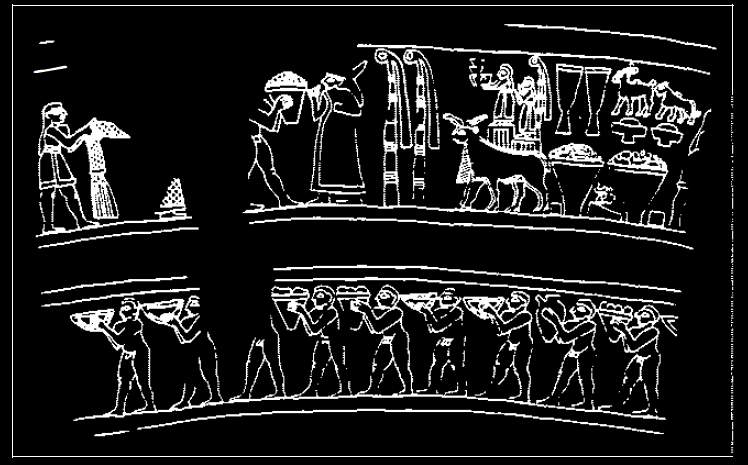 |
|
|
|
Post by sheshki on Jan 24, 2014 16:14:11 GMT -5
from: Syrian Seal Impressions on Tablets Dated in the Time of Hammurabi and Samsu-IlunaAuthor: Edith Porada...shows a sun god in ascending posture and, standing before him, a god holding a mace. Behind the latter is a suppliant goddess as recognizable from traces in the imprint. Behind the sun god is a bull man with a sun standard which is topped by a rosette of small cup-shaped forms, produced with a mechanical drill. 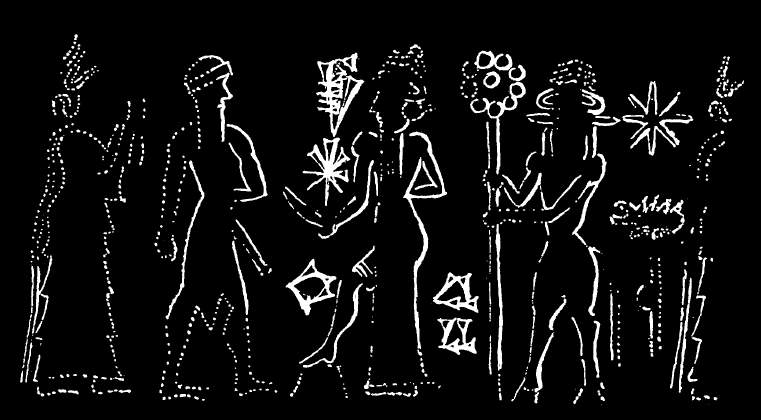 |
|
|
|
Post by sheshki on Apr 5, 2014 18:24:59 GMT -5
from: Religious Rites and Ritual in the Time of Uruk IV—IIIby E. Douglas Van Buren... A young man walks between them holding some object in front of him with both hands. He wears a short skirt of loose-meshed stuff rolled over at the waist to keep it in place. This scene from Tell Billa seems to reveal a late episode in the drama of the sacred marriage; the god has been transported in his boat to the temple with double doors where the marriage took place; the attendants display the distinctive apparel of the divine pair to intimate that the union has been accomplished. In this case it was presumably the god who was the principal figure in the rite, for the doors of the temple are flanked by his symbols, two posts, the upper parts of which are embellished with three pairs of rings. Professor Andrae has sought to prove that this post with its pairs of rings signifies the union of the male and female principle, the fusion of the two elements into one whole. But on other occasions this symbol rises above the byre in which cattle are herded (Fig. 10) , bulls being sacred to a male divinity, in contradistinction to the huts in which sheep were penned which were surmounted by the gate-posts with streamers of Innin, to whom the flocks were consecrated. A pair of these symbols were inlaid on a libation jug of bituminous limestone found in the deposit of votive offerings discovered in Stratum III of the Eanna precinct at Warka. Apparently it was a matter of indifference whether two or three pairs of rings were attached to the upper part of the shaft, for on the cylinder seal from Khafaje the two posts above the doors of the byre have two pairs of rings, whereas the bigger post rising above the middle of the roof has three pairs of rings. This symbol was used as a sign on pictographic tablets of Uruk IV, and the longevity of the conception is demonstrated by a stele of G-udea on which what is perhaps a later version of the symbol is set up on each side of what might be a schematized shrine or tabernacle. This symbol was found in the precinct of Eanna, but like the gate-post with a streamer of Innin herself it has never as yet been discovered in the area of the Anu zikkur- rat. Thus the evidence seems to imply that the post with pairs of rings was the symbol of a male divinity whose cult was honoured in the EOanna precinct and who was worshipped also at Khafaje and Tell Billa, and possibly at Lagaš in late times. The cylinder seal from Khafaje is important, for it was found in the temple of the Moon-god Sin. A remarkable cylinder seal depicts a deity standing in the doorway of a temple to which access was obtained by a flight of step« between broad parapets; a high post with a ring attached to one side near the top is planted to one side of the temple entrance (Fig. 11) . This ringed post is the so-called Bügelschaff or 'huckled spear'. But it was not originally a spear, for its exact form is known. At Lagaš, to north-west of the edifice of Ur-Nanse and lying on an earlier pavement in front of a wall, M. de Sarzec found the copper sheathing of a ringed post, 3.27 m. in length, which must originally have stood at the door of a temple. On the seal the deity, who is rather sketchily portrayed, wears a long robe and extends both arms laterally with open hands in a gesture of acceptance or of welcome to the man who approaches, driving one heron before him and carrying a second in his arms. He is not nude, for the criss-cross pattern of his transparent skirt can be seen across his legs, and it was kept in place by a double girdle round his waist. On a seal in the Louvre the post with a ring attached laterally rises above the roof of a hut around which cattle are gathered, and a pair of these posts flank the entrance to a byre from which calves emerge on a seal impression of the archaic Stratum IV at Uruk . A pair of them are stationed at the door of a temple on a curious cylinder seal from Khafaje. The ringed post is also one of the pictographic signs on clay tablets found in Stratum IV at Uruk; but strong arguments have been brought to bear against the equation of this sign with Nannar, the Moon-god of Ur. The best illus- trations of the ringed post are afforded by seal impressions found in Strata C and A of the Anu Zikkurrat; one depicts two figures walking away from a pair of these symbols, others show the field of illustration empty except for a pair of ringed posts united at the base by a horizontal band as if to represent the threshold of a sanctuary. From its association with herds of cattle the ringed post was assuredly the symbol of a male deity; since in the Eanna precinct only one example of it was found, the seal impres- sion already mentioned representing cattle near a hut, and as numerous examples of it came to light at the Anu Zikkurrat where it was the only symbol represented, the conclusion is forced upon us that the ringed post was originally the symbol of Anu, the Sky-god, and not the star which is generally believed to denote him. Probably the star always had the connotation 'sky', 'heaven', and hence 'dweller in the sky', that is to say 'god', and did not originally signify the god Anu himself who had his own symbol, the post with a ring. A Jemdet Nasr cylinder seal represents the front of a temple with a ringed post rising above the middle of the roof, one on each side of the door, and a big one in the field. Seal impres- sions from the archaic levels SIS 4 - 5 at Ur depict this symbol in pairs , mostly in scenes having to do with the care of cattle, but once in what was obviously a religious rite. At el-'Obeid, where the names of the two early kings, Mes-anni-padda and A-anni-padda, testify to the importance of the cult of Anu, the inlaid frieze from the temple façade pictures men milking cows and two calves coming from a hut with a pair of ringed posts at the entrance. Worshippers bringing gifts for a sacrifice to be performed before the door of a shrine flanked by two ringed posts are shown on the lower register of a stone relief from Ur, as they are on an archaic cylinder seal illustrating a similar subject. It is noteworthy that in the Akkadian period in scenes representing the two nude 'Guardians of the Gate' fulfilling their functions, the gate-posts which they hold (in contradistinction to the wings of the door which they sometimes open) are always in the form of a post with a ring attached to one side near the top. Religious texts reveal the fact that these two guardians were Dumuzi and Ningizzida "who stood at the door of Anu's palace". ... A steatite cylinder seal, believed to be from Sippar, reproduces a more elaborate procession69; two nude priests move to left, both of them carrying high poles surmounted by symbols to which a streamer is attached. One pole is capped by a horizontal bar supporting two small ringed posts, symbols of the god Anu; the second pole bore quite a different emblem, but it is too damaged to be explicable.  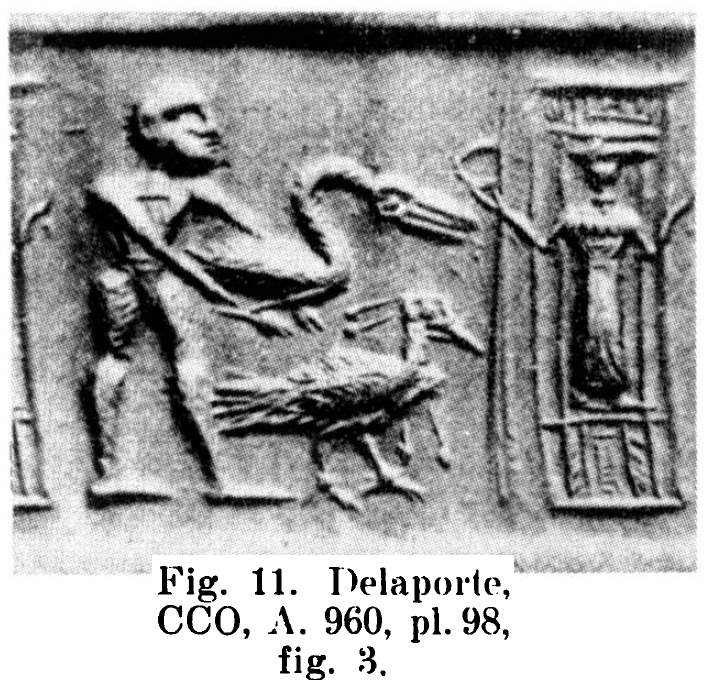 |
|
|
|
Post by sheshki on Sept 21, 2014 19:14:01 GMT -5
Some fine examples from the Louvre. a vessel fragment from the Djemdet Nasr period. 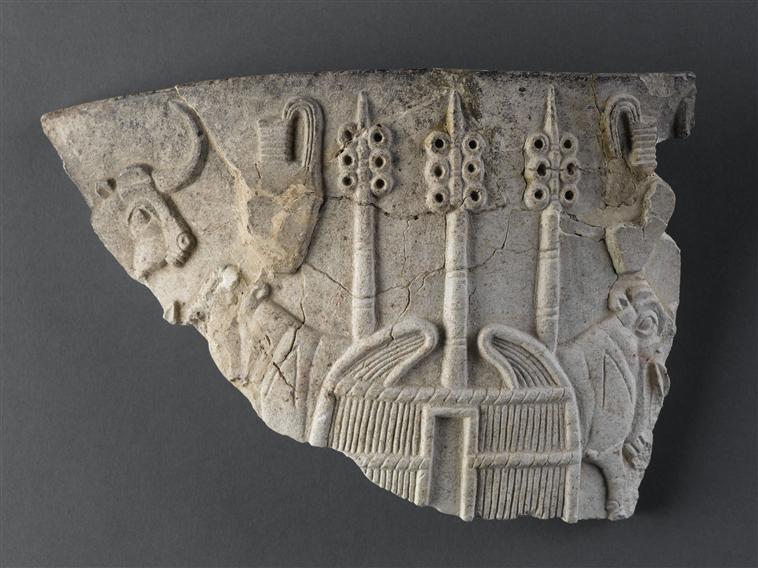 Inanna ringpost to the very left on a cylinder seal, Uruk period 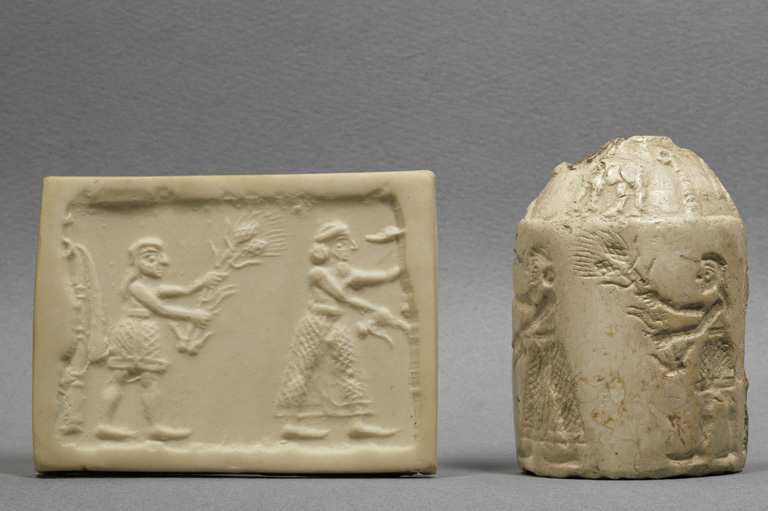 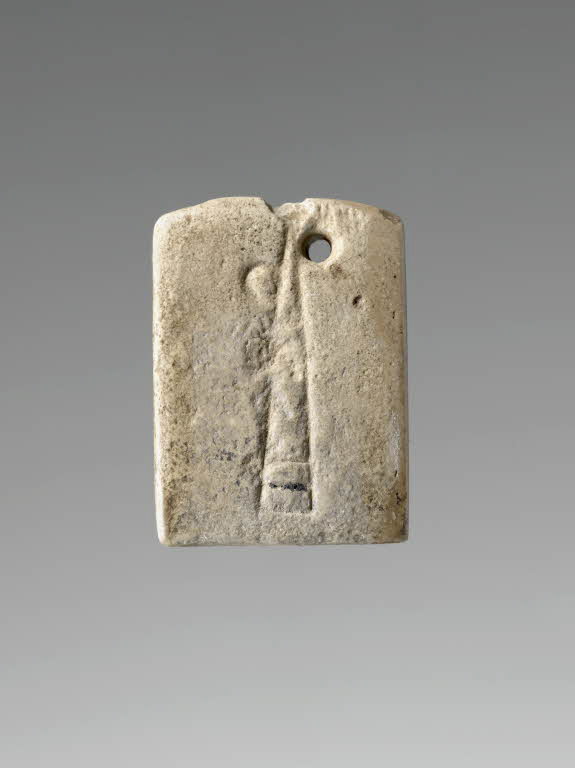 AO 329C 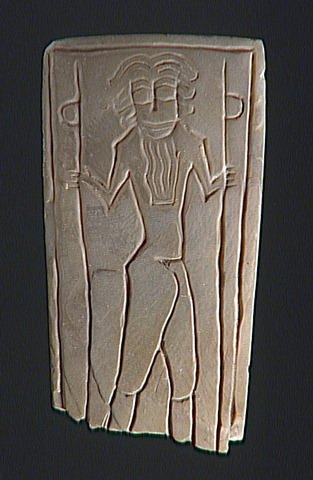 AO 19820 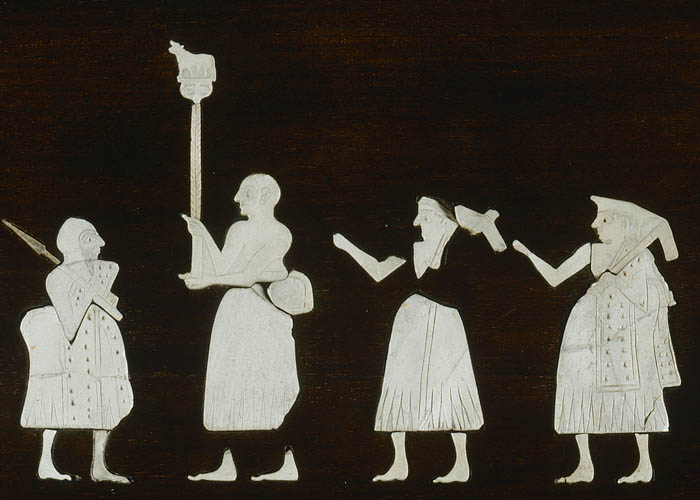 AO 4576 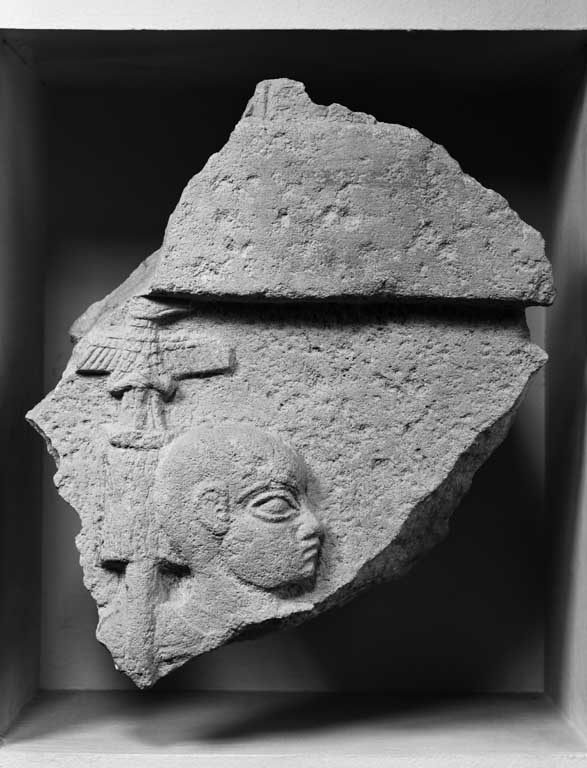 AO 4581 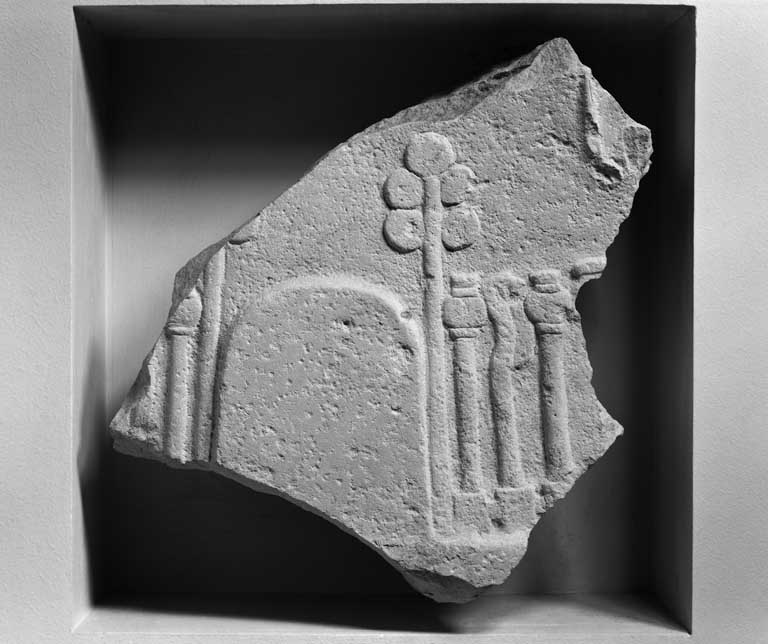 AO 4769 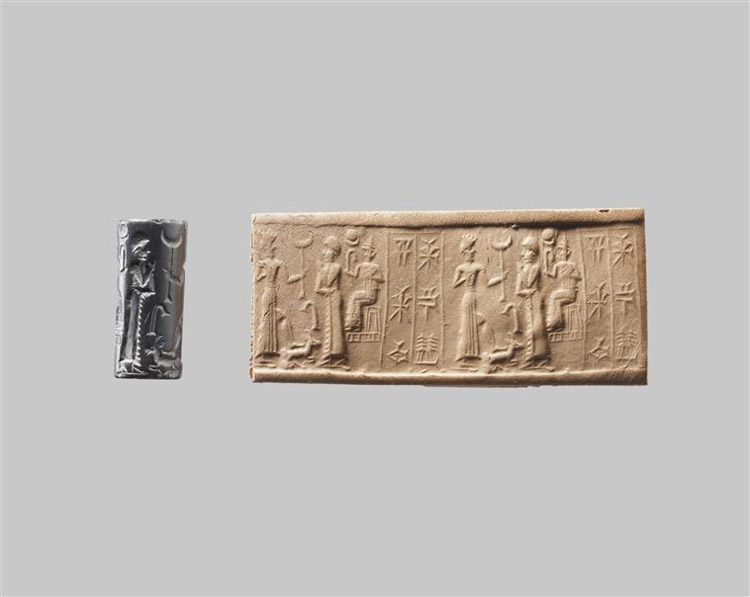 AO 9044  |
|
|
|
Post by sheshki on Sept 28, 2014 11:54:41 GMT -5
More stuff from the Louvre AO 12446 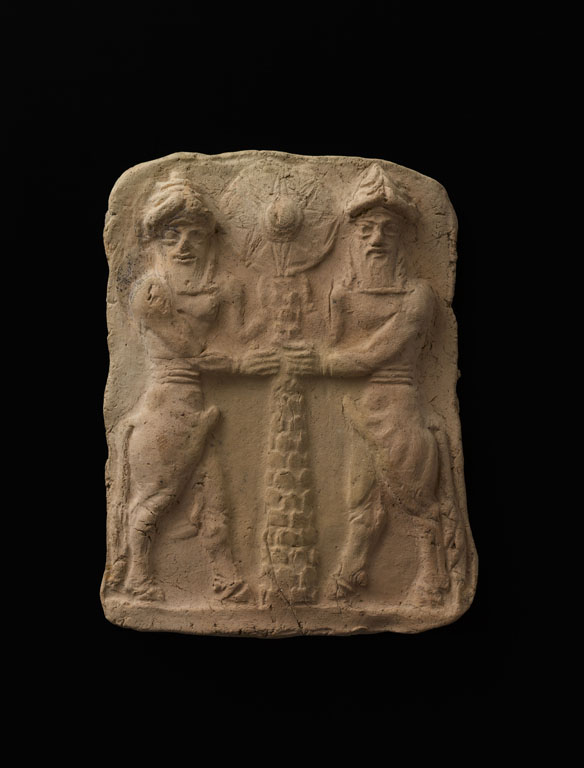 AO 19512 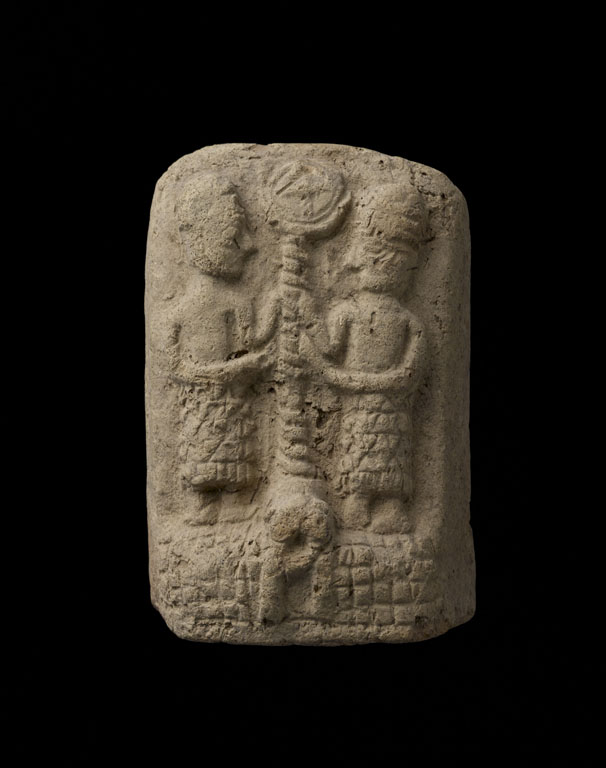 |
|
|
|
Post by sheshki on Oct 6, 2014 6:33:19 GMT -5
|
|
|
|
Post by symbolic on Apr 6, 2015 4:23:06 GMT -5
Sorry, I'm just getting used to the forum so my apologies if this has been answered elsewhere or this is the wrong thread. I've noticed two symbols - a lozenge and a cross inside a further 'box' cross - on a number of Kassite and other seals. Does anyone know their meaning? Any help appreciated, thanks. Attachments:
|
|
|
|
Post by sheshki on Apr 6, 2015 9:32:18 GMT -5
Just found this on the lozenge:
rhomb or lozenge,
Uruk - Neo-Assyrian,
variously explained as a grain of corn, a symbol of earth, an eye or the female vulva. Perhaps a symbol of Ishtar as goddess of prostitutes?
from CANE
|
|
|
|
Post by symbolic on Apr 6, 2015 12:43:02 GMT -5
Just found this on the lozenge: rhomb or lozenge, Uruk - Neo-Assyrian, variously explained as a grain of corn, a symbol of earth, an eye or the female vulva. Perhaps a symbol of Ishtar as goddess of prostitutes? from CANE Thank you, that was quick:) I'm doing research into other areas, trying to correlate meanings from culture to culture; I have this down as a possible symbol for barley or wheat, most probably the latter, so that's interesting. So, does this mean that there is no firm interpretation of this symbol? |
|
|
|
Post by sheshki on Apr 6, 2015 13:07:33 GMT -5
Well, it means i remembered to have posted about it a while ago.  My girlfriend just told me that big amounts of the lonzenges made in fayence were found inside temples of Inanna, i.e. in Nuzi and Ashur, so it was clearly related to her. I will have a look later if i can find more information concerning your question. One has to keep in mind that we are looking at a time span of a couple of thousand years, and meanings change or get lost. |
|